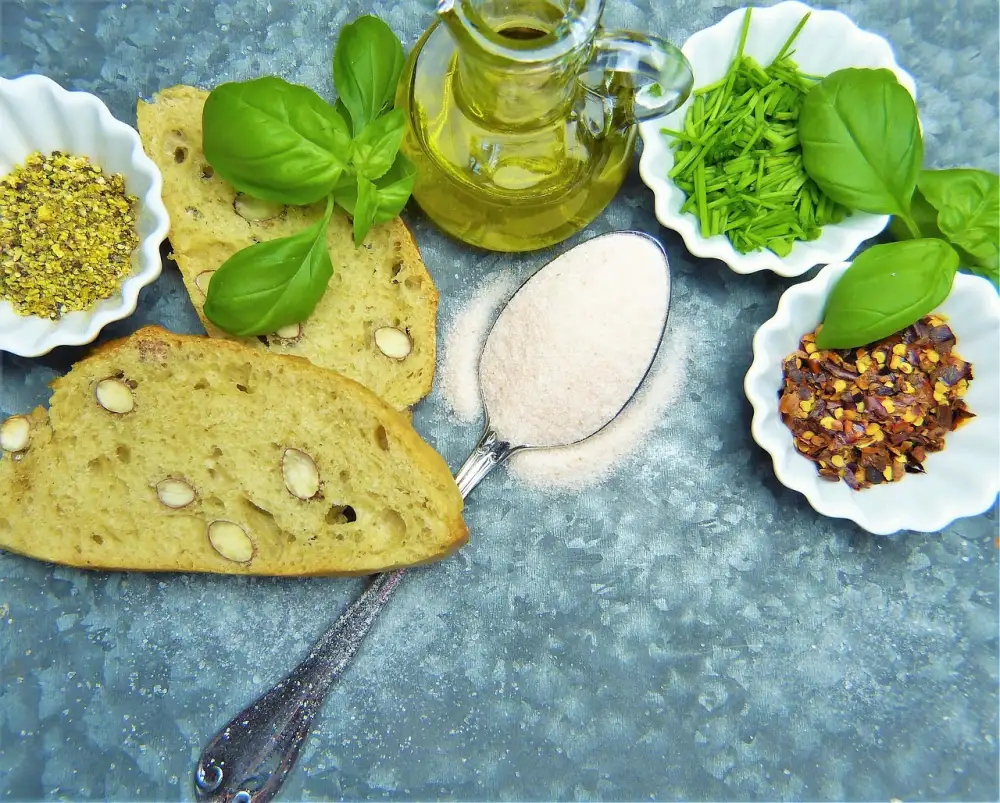Discover the Delights of Gluten-Free Flour: A Healthier Choice for Your Culinary Creations

Gluten-free flour has gained popularity in recent years as a healthier alternative for those with gluten sensitivities or celiac disease. Gluten, a protein found in wheat, barley, and rye, can cause digestive issues and inflammation in some individuals. By using gluten-free flour, you can enjoy a wide variety of delicious dishes without compromising your health. Whether you're baking breads, cakes, or pastries, gluten-free flour offers a world of culinary possibilities that cater to different dietary needs. Join us on this journey as we explore the delights of gluten-free flour and discover how it can enhance your culinary creations while promoting a healthier lifestyle.
Understanding gluten and its effects on health
Gluten is a protein found in wheat, barley, rye, and other grains. For individuals with celiac disease or gluten sensitivity, consuming gluten can lead to a range of health issues. Celiac disease is an autoimmune disorder where the body's immune system reacts negatively to gluten, causing damage to the small intestine. Symptoms include digestive problems, fatigue, skin rashes, and nutrient deficiencies.
Even for those without celiac disease or gluten sensitivity, there is growing evidence that reducing gluten intake can have positive effects on overall health. Some studies suggest that a gluten-free diet may help alleviate symptoms of irritable bowel syndrome (IBS) and improve digestion. Additionally, eliminating or reducing gluten consumption may contribute to weight loss and improved energy levels.
By understanding the effects of gluten on our bodies, we can make informed choices about our dietary habits. Choosing gluten-free flour as an alternative can be a healthier option for those looking to improve their well-being and enjoy delicious meals without compromising on taste or texture.
Benefits of using gluten-free flour
Using gluten-free flour in your culinary creations comes with a multitude of benefits. Firstly, it is a healthier choice for those with gluten sensitivities or celiac disease. By eliminating gluten from your diet, you can alleviate symptoms such as bloating, fatigue, and digestive issues.
Additionally, gluten-free flour is often higher in nutrients compared to traditional wheat flour. It contains essential vitamins and minerals like iron, calcium, and fiber, which are important for maintaining good overall health.
Another advantage of using gluten-free flour is its versatility. It can be used to create a wide range of delicious dishes including breads, cakes, cookies, and pastries. With the right recipe and technique, you can achieve the same taste and texture as traditional baked goods.
Furthermore, incorporating gluten-free flour into your diet opens up a whole new world of flavors and textures. You can experiment with alternative grains like rice, quinoa, buckwheat, or almond flour to add depth and variety to your dishes.
Lastly, using gluten-free flour allows you to cater to the dietary needs of friends and family who may have gluten sensitivities or allergies. By offering them delicious gluten-free options, you ensure that everyone can enjoy your culinary creations without compromising their health.
In conclusion, the benefits of using gluten-free flour are numerous. From promoting better digestion to providing essential nutrients and enhancing flavor profiles in your recipes - embracing this versatile ingredient can lead to a healthier lifestyle while still enjoying the pleasures of cooking joyfully!
Different types of gluten-free flour available
When it comes to gluten-free flour, there are several options available that can cater to different dietary needs and culinary preferences. Some popular types of gluten-free flour include almond flour, coconut flour, rice flour, tapioca flour, and sorghum flour.
Almond flour is made from finely ground almonds and has a slightly sweet and nutty flavor. It works well in baking recipes for cookies, cakes, and muffins.
Coconut flour is made from dried coconut meat and has a light texture with a subtle coconut flavor. It is commonly used in baking recipes for bread, pancakes, and waffles.
Rice flour is made from finely ground rice grains and has a neutral taste. It is versatile and can be used in a variety of recipes such as bread, pasta, and desserts.
Tapioca flour is derived from the cassava root and has a smooth texture. It is often used as a thickening agent in sauces, soups, and gravies.
Sorghum flour is made from ground sorghum grains and has a mild flavor similar to wheat. It can be used in baking recipes for bread, pizza dough, and cookies.
Each type of gluten-free flour has its own unique properties that can enhance the taste and texture of your culinary creations. Experimenting with different types of gluten-free flours can add variety to your dishes while keeping them deliciously gluten-free.
Tips for using gluten-free flour in recipes
When using gluten-free flour in recipes, there are a few tips to keep in mind. Firstly, it's important to remember that gluten-free flours have different textures and absorbency levels compared to traditional wheat flour. This means you may need to adjust the amount of liquid or other ingredients in your recipe.
To prevent your baked goods from becoming dry or crumbly, consider adding a binding agent such as xanthan gum or guar gum. These help mimic the elasticity that gluten provides, resulting in a better texture.
Additionally, it can be helpful to mix different types of gluten-free flours together to achieve the desired consistency and flavor. For example, combining rice flour with almond flour can create a lighter texture and add a subtle nutty taste.
Lastly, be mindful of the cooking time and temperature when using gluten-free flour. Baked goods made with gluten-free flour tend to brown faster than those made with wheat flour, so keep an eye on them while they're in the oven.
By following these tips, you can ensure successful results when using gluten-free flour in your recipes and enjoy delicious dishes that cater to various dietary needs.
Substituting gluten-free flour in traditional recipes
When it comes to substituting gluten-free flour in traditional recipes, there are a few key things to keep in mind. First, it's important to understand that gluten-free flours have different properties than traditional wheat flour. They may absorb more liquid or require additional binding agents to achieve the desired texture.
One common substitution is using a 1:1 ratio of gluten-free flour for wheat flour. This can work well in recipes like cookies or muffins. However, for recipes that rely heavily on gluten for structure, such as bread or pizza dough, you may need to experiment with different combinations of gluten-free flours and binders like xanthan gum or psyllium husk.
Another option is to use a pre-made gluten-free flour blend, which usually contains a mix of different flours and starches. These blends are designed to mimic the texture and flavor of wheat flour and can be a convenient option for those new to gluten-free baking.
It's also worth noting that some recipes may require adjustments in baking time or temperature when using gluten-free flour. Gluten helps trap moisture during baking, so without it, baked goods can dry out more quickly. Keep an eye on your creations and adjust as needed.
Overall, don't be afraid to get creative and experiment with different combinations of gluten-free flours and ingredients. With practice and patience, you'll discover the perfect substitutions that allow you to enjoy all your favorite dishes without compromising on taste or texture.
Health considerations when using gluten-free flour
When using gluten-free flour, it is important to consider the potential health benefits and drawbacks. While gluten-free flour can be a healthier choice for individuals with gluten sensitivities or celiac disease, it is not necessarily healthier for everyone.
One consideration is that gluten-free flours tend to have a lower fiber content compared to their gluten-containing counterparts. This can affect digestion and may lead to constipation if not balanced with other high-fiber foods. It is important to incorporate other sources of fiber into your diet when using gluten-free flour, such as fruits, vegetables, and whole grains.
Another consideration is that some commercially available gluten-free flours may contain additives or preservatives to improve texture and shelf life. These additives may not be suitable for everyone, especially those with specific dietary restrictions or sensitivities. It is always recommended to read the ingredient labels carefully and choose brands that prioritize natural ingredients.
Lastly, it's worth noting that while gluten-free flour can be a great option for those with specific dietary needs, it should not be seen as a weight loss solution. Gluten-free products can still be high in calories and carbohydrates, so portion control and overall balanced eating are key.
In conclusion, when using gluten-free flour, it's important to consider the overall balance of your diet and incorporate other sources of fiber. Additionally, paying attention to ingredient labels and choosing natural options will help ensure you are making the healthiest choices possible.
In conclusion, incorporating gluten-free flour into your culinary creations can be a game-changer for your health and overall well-being. By understanding the negative effects of gluten on our bodies, we can make informed choices to improve our diets.
The benefits of using gluten-free flour are numerous. Not only does it provide relief for those with celiac disease or gluten sensitivity, but it also promotes better digestion and nutrient absorption. Additionally, gluten-free flour opens up a world of possibilities in the kitchen, allowing us to explore new flavors and textures.
With a wide variety of gluten-free flours available, from almond to rice to quinoa, there is something to suit every taste and dietary need. Experimenting with different types of gluten-free flours can add depth and complexity to your dishes.
When using gluten-free flour in recipes, it's important to follow some tips for optimal results. Mixing different types of flours, adding binders like xanthan gum or psyllium husk, and adjusting liquid ratios can help achieve the desired texture and consistency.
For those looking to substitute traditional flour with gluten-free alternatives in their favorite recipes, it may require some trial and error. However, with practice and experimentation, you can create delicious dishes that are both healthy and satisfying.
While embracing the versatility of gluten-free flour is beneficial for many individuals, it's important to consider any potential health considerations. Some people may experience nutrient deficiencies when following a strict gluten-free diet, so consulting with a healthcare professional or registered dietitian is recommended.
In conclusion, by choosing to embrace the versatility of gluten-free flour in our cooking endeavors, we can enjoy a healthier lifestyle while still indulging in delicious meals. So why not give it a try? Your taste buds and your body will thank you!
Published: 17. 12. 2023
Category: Health



